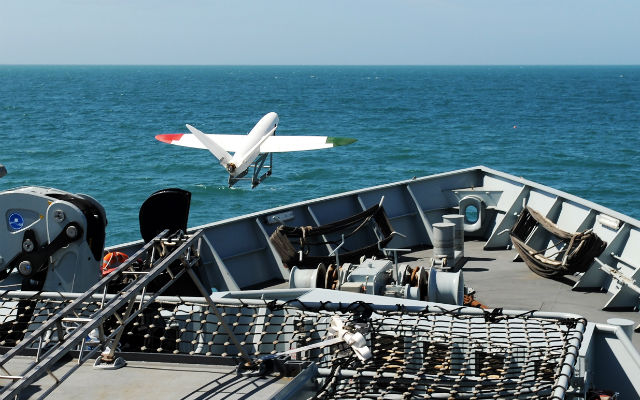A team from the University of Southampton has successfully launched an unmanned air vehicle produced via 3D-printing from the bow of a Royal Navy ship, demonstrating the potential of lightweight platforms to be utilised for short-range surveillance.
Produced under the institution’s Project Triangle, the Southampton University Laser Sintered Aircraft (SULSA) UAV was launched via catapult from the patrol vessel HMS Mersey, and flew over the Wyke Regis training facility near Weymouth in the south of the country to land on Chesil beach.
The 5min sortie covered a range of some 500m, with the UAV carrying a small video payload to record the mission so that operators could monitor it during the flight.
SULSA measures 150cm (59in) and weighs 3kg (6.6lb), and is made via 3D printing using laser sintered nylon. The university claims that SULSA is the world’s first UAV made entirely via the technique. It consists of four separately manufactured main parts that are assembled without the need for any additional tools.
The navy says that the project was supported by the First Sea Lord, Adm George Zambellas, who offered HMS Mersey to aid the development of SULSA.
Under the control of Zambellas, the RN has increased the use of UAVs in its operations, with the most significant development being the introduction of the Insitu ScanEagle platform into its ship-based operations.
The service’s first unit dedicated to unmanned operations – 700X Naval Air Squadron based at RNAS Culdrose in Cornwall – was established in December 2014.
A contractor-owned, contractor-operated arrangement has seen the ScanEagle deployed from Type 23 frigates HMS Somerset, HMS Northumberland and HMS Kent, plus the Royal Fleet AuxiliaryCardigan Bay.
“It’s well known that our first squadron of remotely piloted aircraft have proven their worth in the Gulf, providing persistent airborne surveillance across huge areas of sea,” Zambellas adds, noting that the SULSA trial will help explore how “simple, automated systems have the potential to replace complex machines”.
Insitu’s parent company Boeing confirmed in July that the contract with the UK for ScanEagle has been extended to 2017 from the original two-year £30 million ($47 million) agreement signed in June 2013.
Following this, the navy plans to introduce a new programme that is due to begin in 2022, although it has not yet revealed the requirements for any future unmanned system.
Boeing says that there are no negotiations to continue the ScanEagle operations beyond the current contract terms, but it will “clearly offer it to fill the gap”.
The RN also contracted AgustaWestland in 2013 to carry out a capability concept demonstration under its Rotary Wing UAS programme. Flight demonstrations of the manufacturer’s optionally-piloted SW-4 Solo are understood to have taken place in mid-2015.
Source: Flight Global

